Current Research
BioBlitz Citizen Science Project 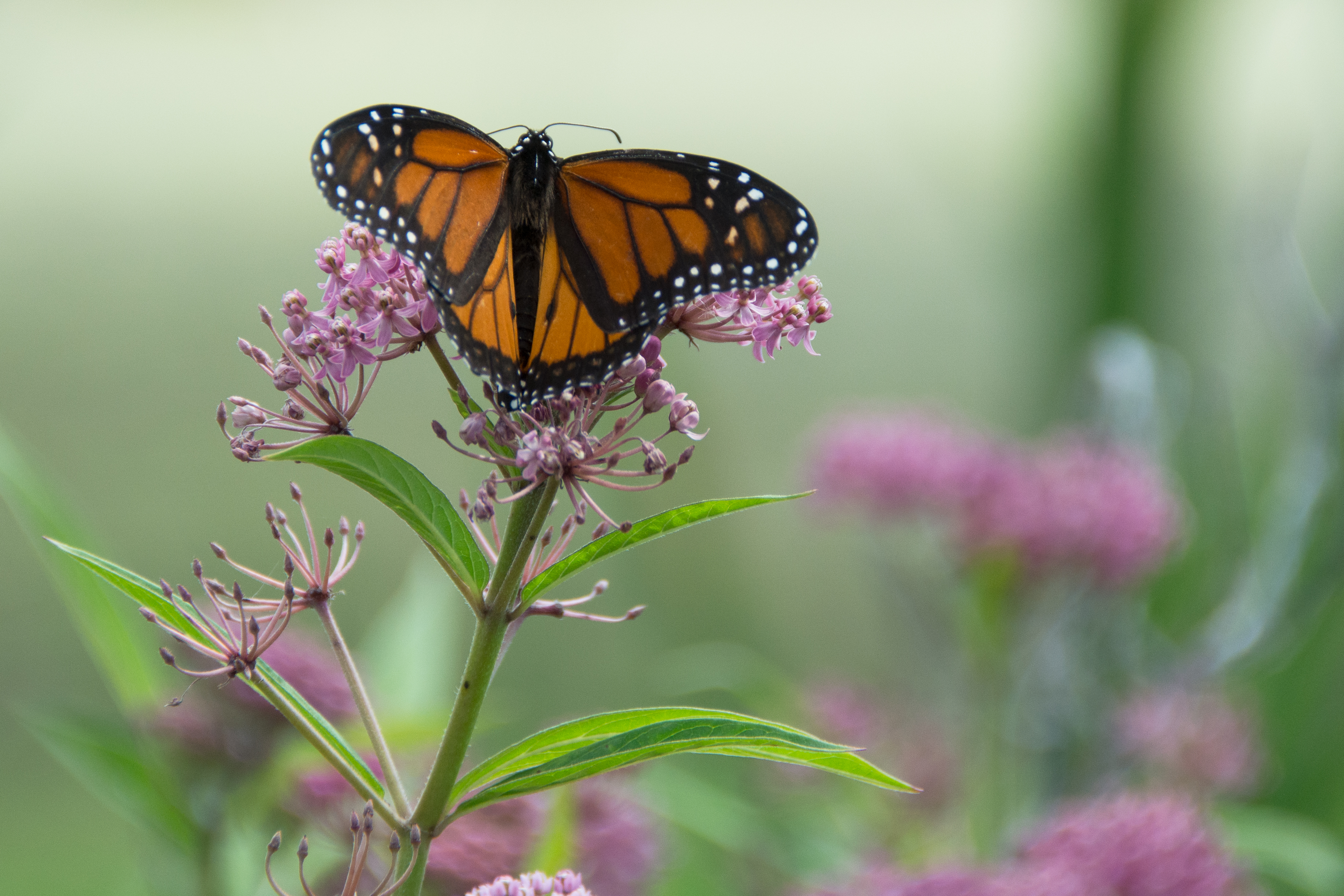
Collaborators: Jen Owen, Alexa Warwick
Units/Partners: MSU Science Festival, MSU Department of Fisheries and Wildlife, MSU Extension
Timeline: 2018 – present
Description: BioBlitz is a periodic event where scientists and the general public work together to survey an area in an attempt to record all the living species there. Our most recent BioBlitz occurred in spring 2024. More than 500 species have been detected thus far, including plants, insects, birds, amphibians, reptiles, mammals, and more! Results from BioBlitz are used to help facilitate long-term planning and research directions.
Cavity Nesting Bird Study 
Undergraduate Students: Hannah Landwerlen, Evan Griffis, Kelly Baltusis, Kelly Craig, Endi Piovesana, Anna Dunnebacke, Gray Longcore, Molli Thibodeau
Mentor(s): Jennifer Owen
Units/Partners: MSU Dept. of Fisheries and Wildlife
Funding Sources: CANR Undergraduate Research Program, MSU AgBioResearch, Glassen Undergraduate Experience, Michigan Bluebird Society, Private Donors
Timeline: 2020 to present
Description: Monotypic vegetation is increasingly prevalent in natural communities due to agricultural activities and the introduction of non-native species. Currently, the open prairie habitat at Corey Marsh Ecological Research Center is dominated by invasive reed canary grass (Phalaris arundinacea). Eastern Bluebirds and Tree Swallows depend on these open fields and prairies to forage for insects, and invertebrates decrease in diversity when vegetation diversity decreases. When fewer distinct prey species are available for bluebirds and swallows in habitats dominated by non-native plant species, there can be major impacts on breeding and nestling health. We are conducting a long-term demography study of these prairie species (EABL and TRES) in relation to wetland and prairie restoration research at CMERC. We are monitoring reproductive success and survival of these indicator species, as well as physiological and nutritional condition through blood sampling of both adults and nestlings. Results from this study will inform managers on the impacts of monotypic vegetation stands on avian health and fitness.
CMERC Wildlife Monitoring Project 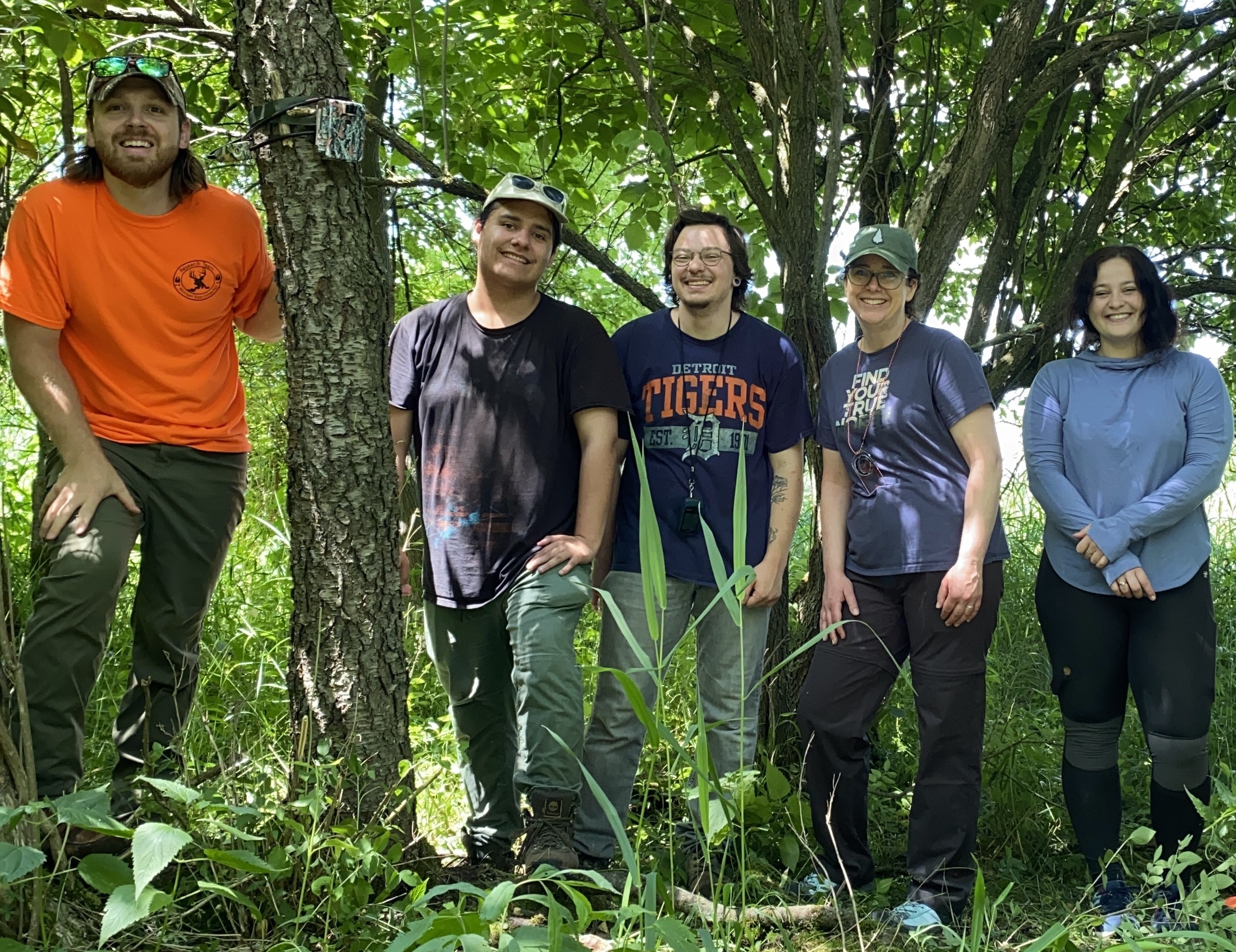
Undergraduate Students: Riley Korus, Gray Longcore, Molli Thibodeau
Mentors: Rose Stewart, Jennifer Owen
Units/Collaborators: MSU Dept. of Fisheries and Wildlife (Hailey Boone, Brett DeGregorio, Steven Gurney)
Funding Sources: MSU Extension, CANR Teaching and Learning Education funds
Timeline: 2023 to present
Description: We have initiated a wildlife monitoring survey using trail cameras to document mammalian presence and activity at CMERC. During summer 2023, a standardized array of 17 cameras (separated by ~300m) were deployed across the property. These motion-triggered cameras operate year-round and are equipped to take images day and night. Images will be collected and reviewed to characterize the mammalian population at CMERC, providing critical baseline information for future research activities. This effort also serves as a platform for training students in field-based research techniques, science communication, and engagement.
Fish Monitoring Project at CMERC
Undergraduate Student: Griffin Bartscht
Mentors: Brian Roth, Jennifer Owen
Units/Collaborators: MSU Dept. of Fisheries and Wildlife
Funding Sources: CANR Undergraduate Research Program, Glassen Undergraduate Experience
Timeline: 2023 to present
Description: We began a fish monitoring program in summer 2023 to characterize the presence, size, and health of fish species inhabiting Corey Marsh. We have very little knowledge about species diversity, population sizes, presence of invasive/nonnative fish species, or the presence of species of conservation concern in the area. We are also testing different trapping techniques to maximize the efficiency of our surveys. We have found that most fish appear to be entering Corey Marsh from Burke Lake located on the MI DNR Rose Lake State Wildlife Area and intend to do parallel surveys at that location for comparison. This project will increase our understanding of the local fish community and provide baseline data for future research studies.
Herpetofauna Monitoring (Herp Team)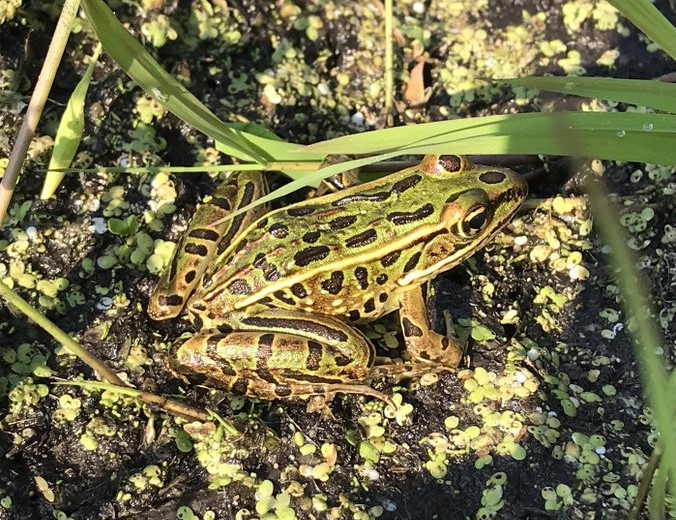
Collaborators: Alexa Warwick, Yu Man Lee, A Proudfoot, Olivia Ruppert, Endi Piovesana, Jen Owen
Units/Partners: MSU Department of Fisheries and Wildlife, Michigan Natural Features Inventory
Funding Source: CANR Teaching and Learning Education funds, NSF DUE award #1914722, US Fish and Wildlife Service, MSU Extension.
Timeline: 2021 - present
Description: Longterm monitoring of organisms is an important way to track changes over time in the species present in an area. For this project we are focusing on herpetofauna or ‘herps’ at Corey Marsh. The term herpetology comes from the Greek word for “creeping animal” and is the study of reptiles and amphibians. Although reptiles and amphibians are not closely related groups (reptiles are more closely related to birds), their seasonal activity patterns and methods for sampling are often similar. In Michigan we have 13 species of frogs and toads; 10 salamanders; 10 turtles; 18 snakes; and 2 lizards, and many of them (6 amphibians, 10 reptiles) are listed as threatened, endangered, or a species of special concern. Conservation efforts rely on a better understanding of the distribution and abundance of such species. Thus, we are collaborating with staff from the Michigan Natural Features Inventory on this project. Beyond simply knowing which species inhabit an area, tracking the same individuals over time also informs our understanding of population demographics. Finally, because amphibians especially are often very sensitive to environmental changes, they can be important indicator species to monitor. Our project goals are to develop a comprehensive herpetology-focused monitoring effort at Corey Marsh that can then serve as an exemplar site to be replicated and implemented elsewhere, with data-sharing across sites to generate larger datasets. The current sampling methods include: (1) salamander mark-recapture using wooden cover boards, with a focus on the red-backed salamander (partnering with SPARCnet), in addition to other salamander species and snakes that are also found under the boards; (2) turtle mark-recapture using hoop traps; (3) frog and toad acoustic call monitoring using both manual surveying and passive frog logger devices; and (4) use of environmental DNA or ‘eDNA’ to detect reptiles and amphibians. Environmental data is also collected at each sampling session. Undergraduate and graduate students are actively involved and even leading some of these herpetology sampling efforts through both independent and course-based research.
Michigan State Bird Observatory
Units/Partners: MSU Departments of Fisheries and Wildlife
Funding Sources: Michigan Department of Natural Resources, Private Donors
Timeline: 2019 to present
Description: The Michigan State Bird Observatory (MSBO) is an umbrella organization that encompasses bird banding, education, and outreach activities at two locations: Burke Lake Banding Station and Corey Marsh Ecological Research Center. The mission of MSBO is to integrate research, train future natural resource professionals, and provide education and outreach for people of all ages – while also promoting the protection and conservation of migratory birds and their habitats. We are particularly interested in the health of migratory birds relative to habitat quality.
Secretive Marsh Bird Study 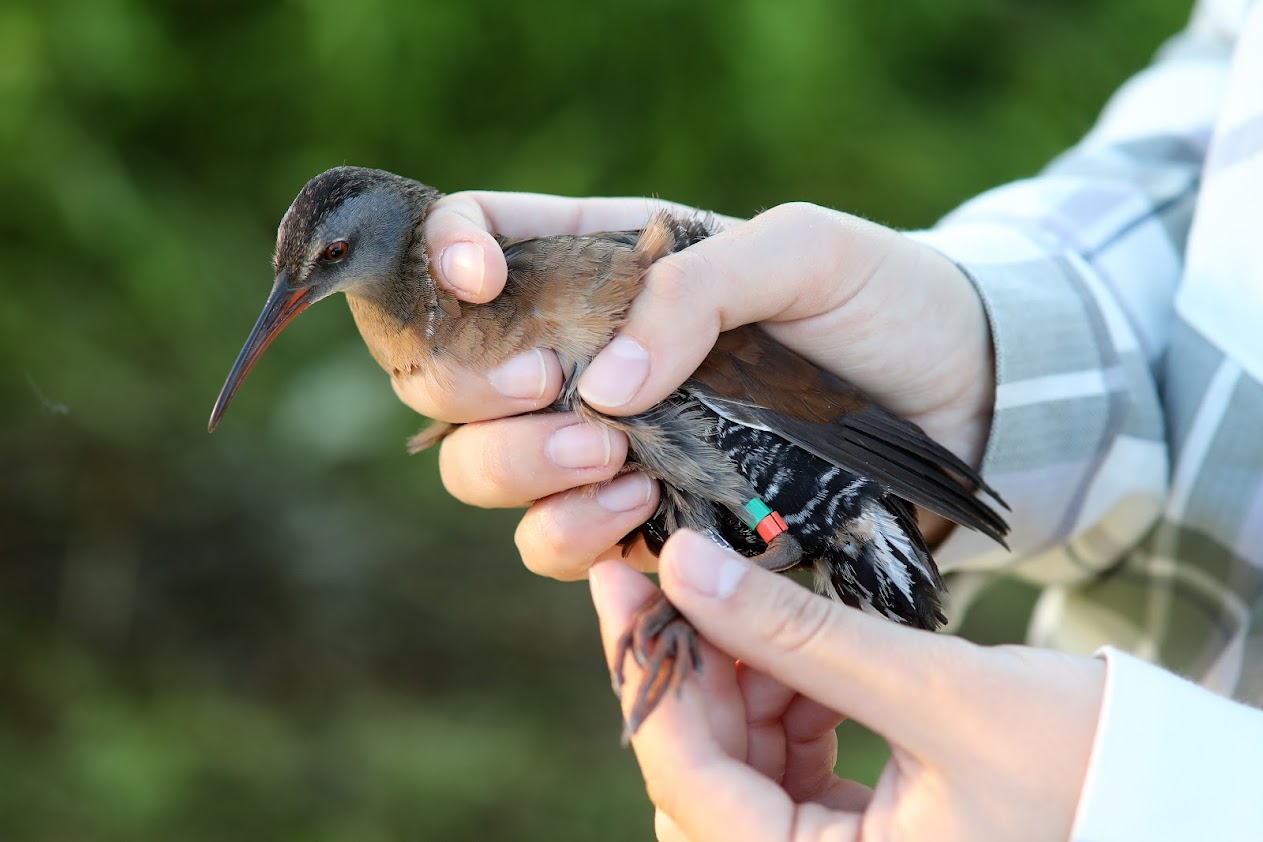
Undergraduate Students: Hannah Landwerlen, Evan Griffis, Kelly Baltusis, Kelly Craig, Endi Piovesana, Anna Dunnebacke, Gray Longcore, Molli Thibodeau
Mentor(s): Jennifer Owen
Units/Partners: MSU Dept. of Fisheries and Wildlife
Funding Sources: CANR Undergraduate Research Program, MSU AgBioResearch, Glassen Undergraduate Experience, Private Donors
Timeline: 2020 to present
Description: Secretive marsh birds are important indicators of the health of emergent vegetated wetland ecosystems and are state-listed species of concern in most of the states in which they breed, including in Michigan. Populations have declined with the loss and degradation of wetlands, primarily through the expansion of agricultural activities and draining of land for growing crops. Additionally, secretive marsh bird are sensitive to invasion of non-native species, particularly Virginia rails whose abundance is negatively associated with presence of monotypic reed canary grass. We are conducting a long-term demography study of these marsh species (VIRA and SORA) in relation to wetland and prairie restoration research at Corey Marsh Ecological Research Center. We are monitoring reproductive success and survival of these indicator species, examining (1) the availability of food through arthropod sampling, and (2) the birds’ diet through opportunistic fecal sampling. Results from this study will inform managers on the impacts of monotypic vegetation stands on avian health and fitness.
Sedge Wren Ecology Study .jpg)
Undergraduate Students: Trevor Markwood, Anna Dunnebacke, Gray Longcore, Molli Thibodeau
Mentor(s): Melissa Charenko, Jennifer Owen
Units/Partners: MSU Lyman Briggs College, MSU Dept. of Fisheries and Wildlife
Funding Sources: MSU Lyman Briggs Undergraduate Research Support
Timeline: 2023 to present
Description: Sedge wrens (Cistothorus stellaris) are small brown songbirds known for being a nomadic species, meaning they typically end up in different locations every year when they migrate. As a result, there can be a multitude of sedge wrens in an area one year, but the next year there could be none. Interestingly, Corey Marsh Ecological Research Center has been home to a plethora of sedge wrens every year for the past several years, and we are trying to determine what factors may be attracting them to this habitat. To better understand sedge wren ecology, we are conducting ground surveys to map out sedge wren territories. We also plan to conduct nest surveys to locate their nests and characterize nest composition, surrounding vegetation coverage, and other important factors. Our intent with this research is to discover why sedge wrens love Corey Marsh so much and what factors cause them to return every year. This information will allow for further research to investigate how sedge wrens affect the marsh and how the marsh benefits these birds.
Survey of Historical Pesticide Use 
Undergraduate Students: Sofie Johnson. Riley Korus
Mentors: Melissa Charenko, Jennifer Owen
Units/Partners: MSU Lyman Briggs College, MSU Dept. of Fisheries and Wildlife
Funding Sources: MSU Lyman Briggs Undergraduate Research Support, MSU Extension
Timeline: 2023 to present
Description: The MSU Muck Soils Research Farm (MSRF) operated on the site of the current Corey Marsh Ecological Research Center from 1941 to 2012. We are interested in the history of pesticide and fertilizer use at the MSRF during its 70 years in operation and how these activities may impact soil conditions today. Undergraduate students are conducting a survey of chemical use by reviewing historic journals kept by the farm managers between 1970 and 1985 as well as the annual reports produced by the farm. Once students determine which areas of the property were most heavily affected, a soil analysis will be done to compare soil characteristics at different locations. This research is important to help get an understanding of possible legacy chemicals that could still be present in the soil today. The analysis will help researchers determine future actions that can be taken to restore and rehabilitate the site to its natural state.
Wild Rice Growth Study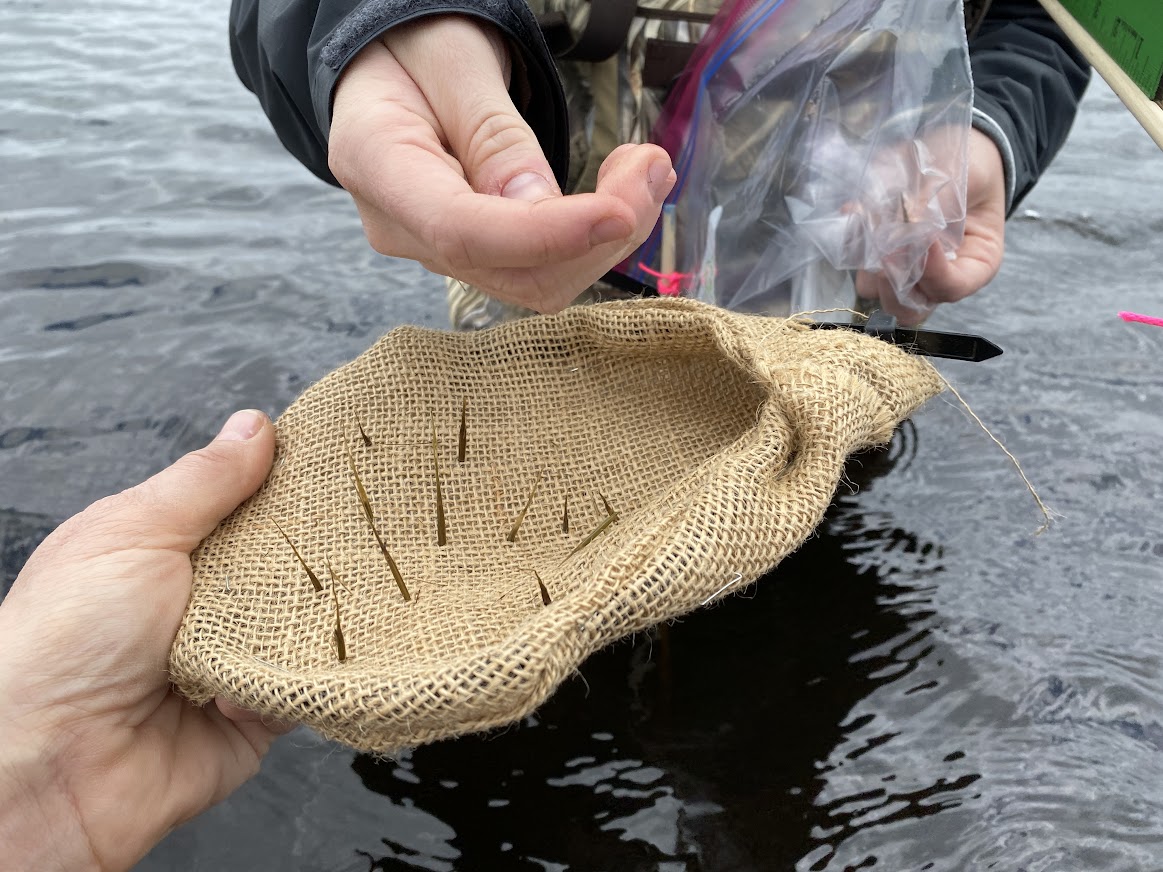
Undergraduate Students: Kailee Pearson, Jordan Zapata, Maggie Dobry
Mentor(s): Jennifer Owen, Matt Chansler
Units/Partners: MSU Dept. of Fisheries and Wildlife, MSU Dept. of Plant, Soil, and Microbial Sciences
Funding Sources: CANR Undergraduate Research Program, Society for Ecological Restoration, Private Donors
Timeline: 2022 to present
Description: Wild rice (Zizania aquatica) is a grass native to wetlands of the Great Lakes Region. Being native, the plant has existed with all the plants and animals around it for thousands of years. Wild rice is ecologically and culturally important, creating habitat for wildlife and food for people. The wild rice project at Corey Marsh Ecological Research Center is a study on the environmental conditions affecting the growth of wild rice in the marsh. Started by undergraduate student and member of the Sault Ste. Marie Tribe of Chippewa Indians Kailee Pearson in 2022, this project is a continuation of her work with the Sault Tribe Wildlife Program as a field technician. Before the project was initiated, there was no wild rice growing in the Corey Marsh. During the first year, Kailee correctly predicted that the marsh’s muck soils would provide the perfect conditions for wild rice growth but observed that rice don’t survive large fluctuations in water level or major herbivory. Now in its second year, the project has wild rice growing in four plots, each with a section that allows and excludes herbivory using wire fencing. We know the rice is sensitive, and it usually disappears when a wetland is disturbed by pollution or draining. Therefore, in 2023 environmental conditions including soil quality and water depth are being measured, as well as growth, to determine a relationship between these factors. As the rice continues to grow and we learn more, we hope to understand how marsh conditions affect the growth of the rice, and how the rice affects the health of the marsh.




 Print
Print Email
Email